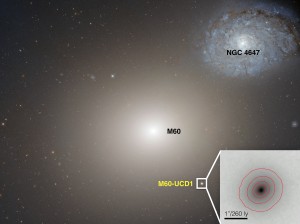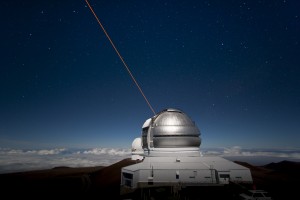Two Australian astronomers are part of the international team who found a supermassive black hole inside the smallest known galaxy.
A partnership between the Australian Astronomical Observatory and Macquarie University has supported the key roles played by Dr Richard McDermid and Dr Lee Spitler in making the discovery, led by University of Utah astronomer Anil Seth.
Seth, McDermid and Spitler’s ‘star’ team discovered that an ultracompact dwarf galaxy known as M60-UCD1 harbors a supermassive black hole – and it’s the smallest galaxy known to contain such a massive light-sucking object.
“This object is bizarre – it is the smallest thing we’ve ever found to harbor such a large black hole,” said Spitler. “Even the Milky Way, which is 500 times larger than M60-UCD1, has a smaller black hole.“
“The size of a supermassive black hole usually relates to the size of the galaxy it lives in,” says McDermid, “so if small, compact galaxies like M60-UCD1 formed like other galaxies, we’d expect them to have fairly small black holes at their centres.
“Instead, in M60-UCD1 we found a supermassive black hole that is way out of proportion – about 1500 times larger than was expected.”
“What we think happened was that M60-UCD1 was once a normal galaxy, probably a little bigger than the Milky Way.” said Spitler “The old M60-UCD1 likely had a head-on collision with another, much larger galaxy called M60.
“All that is left of M60-UCD1 is just its core – the rest of it was ripped apart. So we think we found the dense stellar core of a destroyed galaxy.”
As part of the international science team, the two joint Macquarie-AAO staff members contributed access to the Gemini North Observatory – an 8 metre telescope in Hawaii funded by Australia as part of an international partnership.
“Even with this huge telescope, it's a difficult measurement to make,” says McDermid. “To estimate the mass of the supermassive black hole, we required Gemini’s laser guide star adaptive optics system to correct the light from M60-UCD1 for distortions caused by Earth’s atmosphere – kind of like removing the ‘twinkle’ from the stars.”
The Hubble Space Telescope was also used in the discovery.
“There are a large number of ultracompact dwarf galaxies in the universe,” says Anil Seth, lead author of the international study of the dwarf galaxy published in the journal Nature. “Together they may contain as many supermassive black holes as there are at the centers of normal galaxies.” This would double the number of supermassive black holes in the Universe.
The study – conducted by Seth, McDermid, Spitler and 11 other astronomers – was funded by the US National Science Foundation, the German Research Foundation and the international Gemini Telescope partnership, which includes the NSF and scientific agencies in Canada, Chile, Australia, Brazil and Argentina.
'A supermassive black hole in an ultra-compact dwarf galaxy', Nature, Vol 513, September 2014, Anil C. Seth, Remco van den Bosch, Steffen Mieske, Holger Baumgardt, Mark den Brok, Jay Strader, Nadine Neumayer, Igor Chilingarian, Michael Hilker, Richard McDermid, Lee Spitler, Jean Brodie, Matthias J. Frank & Jonelle L.Walsh, doi:10.1038/nature13762
A partnership between the Australian Astronomical Observatory and Macquarie University has supported the key roles played by Dr Richard McDermid and Dr Lee Spitler in making the discovery, led by University of Utah astronomer Anil Seth.

Seth, McDermid and Spitler’s ‘star’ team discovered that an ultracompact dwarf galaxy known as M60-UCD1 harbors a supermassive black hole – and it’s the smallest galaxy known to contain such a massive light-sucking object.
“This object is bizarre – it is the smallest thing we’ve ever found to harbor such a large black hole,” said Spitler. “Even the Milky Way, which is 500 times larger than M60-UCD1, has a smaller black hole.“
“The size of a supermassive black hole usually relates to the size of the galaxy it lives in,” says McDermid, “so if small, compact galaxies like M60-UCD1 formed like other galaxies, we’d expect them to have fairly small black holes at their centres.
“Instead, in M60-UCD1 we found a supermassive black hole that is way out of proportion – about 1500 times larger than was expected.”
“What we think happened was that M60-UCD1 was once a normal galaxy, probably a little bigger than the Milky Way.” said Spitler “The old M60-UCD1 likely had a head-on collision with another, much larger galaxy called M60.
“All that is left of M60-UCD1 is just its core – the rest of it was ripped apart. So we think we found the dense stellar core of a destroyed galaxy.”
As part of the international science team, the two joint Macquarie-AAO staff members contributed access to the Gemini North Observatory – an 8 metre telescope in Hawaii funded by Australia as part of an international partnership.

“Even with this huge telescope, it's a difficult measurement to make,” says McDermid. “To estimate the mass of the supermassive black hole, we required Gemini’s laser guide star adaptive optics system to correct the light from M60-UCD1 for distortions caused by Earth’s atmosphere – kind of like removing the ‘twinkle’ from the stars.”
The Hubble Space Telescope was also used in the discovery.
“There are a large number of ultracompact dwarf galaxies in the universe,” says Anil Seth, lead author of the international study of the dwarf galaxy published in the journal Nature. “Together they may contain as many supermassive black holes as there are at the centers of normal galaxies.” This would double the number of supermassive black holes in the Universe.
The study – conducted by Seth, McDermid, Spitler and 11 other astronomers – was funded by the US National Science Foundation, the German Research Foundation and the international Gemini Telescope partnership, which includes the NSF and scientific agencies in Canada, Chile, Australia, Brazil and Argentina.
'A supermassive black hole in an ultra-compact dwarf galaxy', Nature, Vol 513, September 2014, Anil C. Seth, Remco van den Bosch, Steffen Mieske, Holger Baumgardt, Mark den Brok, Jay Strader, Nadine Neumayer, Igor Chilingarian, Michael Hilker, Richard McDermid, Lee Spitler, Jean Brodie, Matthias J. Frank & Jonelle L.Walsh, doi:10.1038/nature13762



